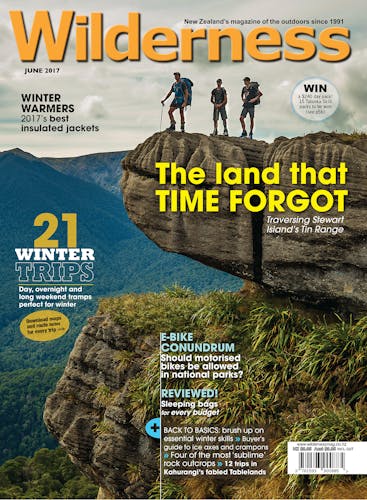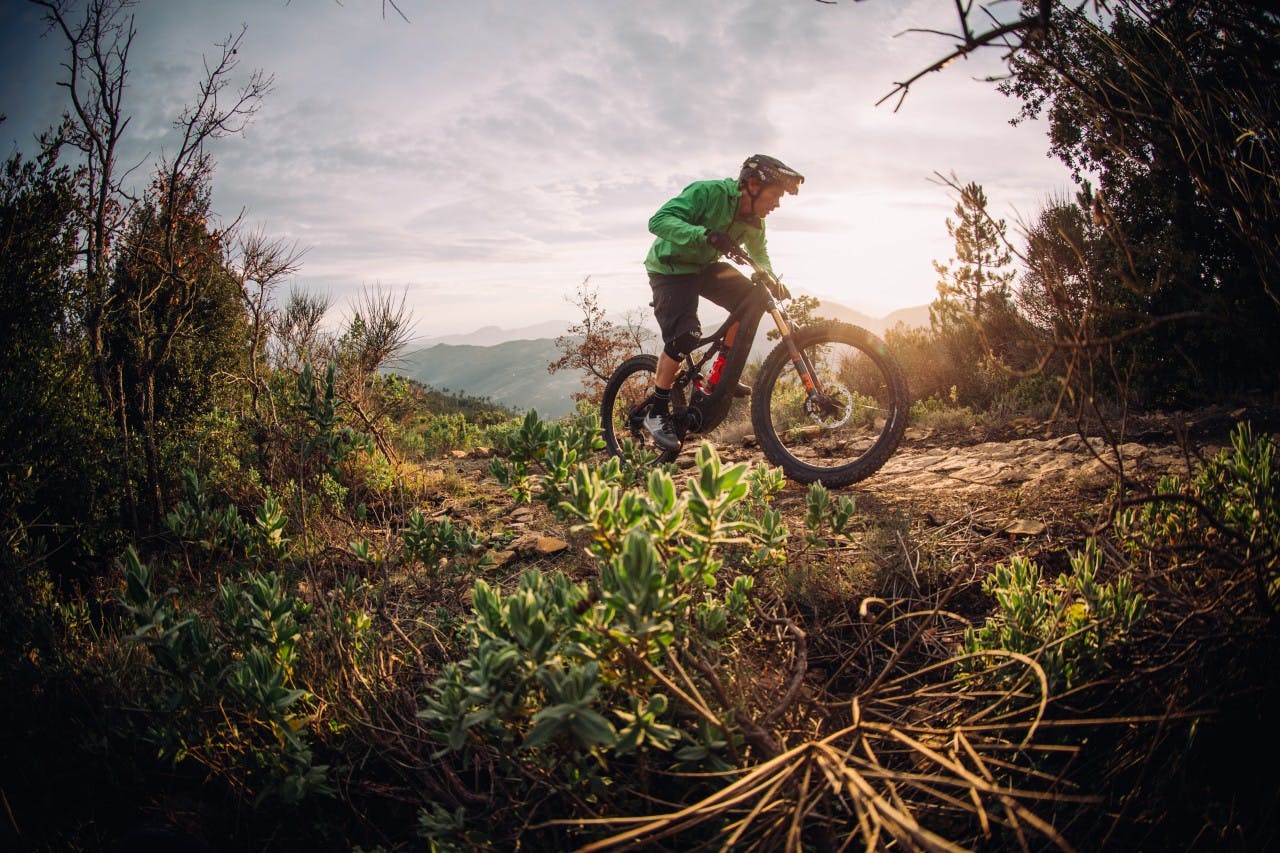As e-bikes gain in popularity, Meghan Walker looks at the pros and cons of allowing motorised bikes in national parks
At first glance, the bike I was about to hop on looked exactly like a heavy-duty mountain bike. Fat tires, impressive shocks, and a sturdy design. Except for one almost imperceptible difference: a power button with green flashing lights on the centre frame.
This is a mountain e-bike. Its motor kicks into motion when you pedal, giving an extra burst of speed when you need it. Battery powered and with a 250-watt motor, its top speed is about 25km/hour. It weighs 23kg, and it rides just like a normal bike – until its pedal-assist sensor decides you need some help.
While e-bikes have been a celebrated new technology for the road bike commuter, their appearance on mountain bike trails has irked some in the biking community. Slowly but surely, mountain e-bikes are showing up on trails around the country, including in Tongariro National Park. And now, the Department of Conservation is proposing an amendment to the park’s management plan to officially allow e-bikes on conservation land.
Because e-bikes have only recently become more common, they aren’t included in any national park plans, and therefore aren’t technically allowed. DOC’s national park general policy is that powered vehicles such as motorised bicycles are only permitted on formed roads and tracks that have been specifically designated for their use.
However, DOC has chosen to make monitoring compliance around e-bike use in national parks a low priority. DOC permissions and statutory land management manager Deidre Ewart says that’s mainly because they haven’t noticed any adverse effects in Tongariro, or had complaints from other trail users.
The proposal to include e-bikes in the Tongariro National Park plan arose in conjunction with a proposal to build three new trails.
Ewart says that through the track proposal process, “it became evident that there was a growing trend of the use of mountain e-bikes. We came to the realisation that, in fact, it would be more than likely that e-bikes would be used on the tracks, whether we provide for them or not, and this is a good opportunity to go through the public process and propose the conditions that we think e-bikes should be used under.”
Mike Fraser owns the Mountain Bike Station in Ohakune, which rents out traditional mountain bikes and offers a shuttle service for cyclists who want to do a one-way ride in the national park.
Fraser says it’s common for his shuttle company to transport at least one e-bike a week. He sees no issues with the new technology, pointing out that the riders of e-bikes aren’t typically the bikers you have to worry about.
“You get nutters on their fast downhill bikes going 80km/hour. They’re going 10 times faster than a 60-year-old on an e-bike. They’re much more lethal. They’re the risk. It’s not the old codger on his e-bike.”

Rowan Van Lier from Specialized says e-bike sales are steadily increasing. Photo: Supplied
However, many in the mountain biking community see the potential inclusion as a reckless move. Biking advocacy leaders say there should be trials and studies to examine the potential impacts. They worry about the speeds e-bikes can reach, and if the technology will make them as powerful as motorbikes.
Standing outside the Auckland Specialized distributor’s office in Mt Eden, I hopped on their first-generation e-bike, the Levo, to give it a try.
“Pedal harder!” Specialized retailer care manager Rowan Van Lier called to me as I started off down the driveway. I changed gears, stepped down hard on the pedals, and felt the motor kick in. It was completely silent, and the acceleration was gradual enough that for a moment, I wondered if it was actually on at all.
The technology of e-bikes is improving steadily; the Levo has a bluetooth-enabled smartphone application that allows a rider to manage the battery life, motor output, and even the acceleration rate. For example, if you know you’re doing a 50km ride, you can control the output levels to ensure the battery will last the whole ride.
Van Lier says the e-bike scene is growing fast; one of his retailers, a store in Taupo, averages one sale a week.
And who rides e-bikes? Van Lier says it was initially thought it would be older generation riders and people with injuries. But they’re increasingly seeing younger riders who want to stay on the trails for longer.
“There are worries that people are going to abuse the power you have from these. Other brands you might be able to go faster than 25km an hour, or hack the motor to make it go faster. But to be honest, anyone can be a jerk on a bike, regardless of what bike you’re on. It’s more about consideration for others,” Van Lier says.
Most e-bikes are under the 300w power output, which is comparable to the power produced by a kitchen blender. Van Lier says this is nominal wattage compared to what experienced riders can produce under their own steam.
“Someone like Sam Gaze, one of the best New Zealand riders, would be putting out 500w to 1000w just under his own power. [With e-bikes] we’re not talking professional athlete levels, it’s just enough to assist you up the hill.”
Last year, the Nelson Mountain Bike Club (NMTBC) became the first club in the country to adopt an e-bike policy. Club secretary Paul Jennings says it was clear that e-bikes were steadily becoming more common, so the club committee did some research and included a few guidelines for members: all e-bikes up to 300w would be permitted on club trails, with land manager permission; e-bikes over 300w would be treated as motorbikes, and as such would be banned on trails; and the club encourages its members to self-police the use of e-bikes on their trails.
Jennings says roughly five per cent of their 2500 members are currently using e-bikes, but he wouldn’t be surprised if that jumps to 30 per cent in the next couple of years.
“You see them regularly now. They’re still a minority on our trails, but it’s becoming normal.”
Jennings says Nelson is full of e-bikes; they’re popular on the cycle trails such as the Great Taste Trail; operators often rent them out to tourists who want to see the area and get a bit of exercise. The club’s annual Copper Mine competition even had an e-bike category this year, with about 30 e-bikers.
Members use e-bikes regularly for everything from trail maintenance to marking trails for events, and even to transport medics to injured riders along the trail. Jennings says the e-bikes allow them to work on the trails quickly and more often, saving their volunteers time and energy. While he primarily uses his traditional mountain bike, the e-bike comes in handy for recreation too.

Paul Jennings uses his e-bike to help his young daughter keep up with him in the hills. Photo: Supplied
“I have a six-year-old, and my wife and I would have to really compromise a ride if she wanted to come with us. But now I can put a little leash on her bike and drag her along behind the e-bike and get her to the top of the hill, and she thinks it’s the best thing ever,” Jennings says.
“It’s added a new dimension to our riding. It hasn’t stopped me being a mountain biker, but it’s just taken away one of the reasons why we wouldn’t go cycling as a family.”
One of the big concerns initially was that the e-bikes would cause extra damage to the trails. However, after a year of e-bikes regularly on their trails, Jennings says they haven’t seen any increased wear and tear.
“The more you ride one, the more you realise it’s an assisted mountain bike. It isn’t a motorbike and there’s no more trail erosion that we’ve found,” he says. “We think it’s a really positive thing for the general public in terms of enabling more people to mountain bike. Especially in Nelson, where it’s pretty steep and hilly. These bikes enable more people to do it.”
While e-bikes are a good thing for their club, Jennings says the important thing is to keep a handle on the power output.
“The challenge now is for the industry to play by the rules,” he says. “Anything above the threshold of 300w blurs the boundaries. We’re looking to the industry to be responsible and take the lead.”
Generally, the mountain biking community has been cautious about the introduction of e-bikes on trails. Nessa Lynch is co-founder of Trail Fund, a nonprofit advocacy group that focuses on biking trail development and maintenance.
“It’s quite a contentious issue, [but] I support e-bikes in the right environment,” she says, referencing how many e-bike commuters she now sees on a daily basis in Wellington.
“I think they’re wonderful on cycle trails and 4WD trails, but I think we need to be cautious on single track trails,” Lynch adds. “I’m very much keeping an open mind and I know we very well may see them in national parks, but I think we need to be cautious.”
Lynch has a lot of questions about the impact of e-bikes; on trails, on other trail users, and on their safety on narrow trails. She’d like to see trials before allowing the bikes in national parks. For example, she points to Wellington City Council, which is currently running an e-bike trial in a nearby mountain biking park to determine the impacts on the trails and other riders.
“For the national parks, we should wait and see the results of some of these trials, rather than jumping in and doing this immediately, especially in a very sensitive area.”
Lynch had the opportunity to try out an e-bike recently, and wasn’t too impressed.
“They weren’t as powerful as I’d imagined, but I still found them a bit scary with the amount that it jumps forward. If you were on a corner or somewhere with a drop-off [when it accelerates] – I have a personal concern about that.”
As designs of mountain e-bikes evolve, it will likely be increasingly difficult to tell the difference between an e-bike and a traditional mountain bike. Currently, the e-bikes that look similar to regular bikes are quite heavy, and the battery doesn’t last for very long.

Nessa Lynch says DOC should be cautious about allowing e-bikes in national parks. Photo: Supplied
That would make it quite ludicrous to take an e-bike on a long track like the Heaphy. The battery would die after the first day, and then you’d be stuck pedalling an overweight bike for the rest of the trip.
Lynch is also concerned about the motivation behind the proposal.
“If it were a group of local e-bike users who were really interested in doing their recreation, that would be different. Whereas the Tongariro National Park proposal seems to be, ‘build it and they will come’, on a commercial enterprise,” she says. “In my view, it puts a slightly different colour on it.”
Guy Wynn-Williams is one of the co-founders of Ground Effect, a mountain biking gear company and advocacy group. Similarly to Lynch, he sees the benefits of the technology, but is hesitant to see e-bikes used in national parks.
“It polarises people into for and against, but it’s clearly not as simple as that,” Wynn-Williams says. “E-bikes are fundamentally a good thing. They’re a great opportunity for commuting, and are great for less-fit, less-able riders who can still have an outdoor experience on an easier cycle trail, which they might not otherwise do.”
But he says there are complex issues to contend with. Firstly, the definition of an e-bike can be blurry. Generally, it’s understood to be a pedal-assisted bike under 300w. However, “there are lots of other beasts out there,” he says, that are over 300w, and therefore are not trail-legal.
“It’s fair to say that future e-bikes will be considerably faster, more powerful, and have longer range, and more importantly, be very difficult to differentiate from any other sort of bike – with a motor or without.”
Wynn-Williams points out that because they’re still new on the mountain biking scene, there hasn’t been enough time to understand the physical and social impacts.
“E-bikes are an exciting opportunity, they’re very new, their future is uncertain, and what that means is that we need a great deal of caution.”
He, like Lynch, advocates for an e-bike trial in a more controlled environment.
“National parks deserve a more conservative approach to development and recreational opportunities. So I think it’s a bit adventurous for DOC to suggest using e-bikes in a national park until their impacts are known, and until they, and other land managers, can gain some experience in what it takes to define and encourage compliance into the power and type of e-bike they envisage will be used.”
Probably the biggest concern most people have, he says, is that it can be extremely difficult to determine the power in a given e-bike. It’ll be up to DOC to force compliance, and Wynn-Williams is skeptical about their ability to do so.
DOC is accepting public submissions on the Tongariro NP partial plan review until May 29, with the final decision to be made by the New Zealand Conservation Authority later this year.
For now, DOC will continue to allow the use of e-bikes in Tongariro.








